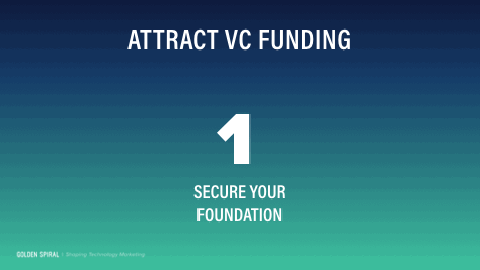How to Position Your SaaS Company for a Venture Capital Firm

The Article in 60 Seconds
You won’t get many opportunities to present your SaaS start-up to a Venture Capital (VC) firm with the desire to receive a large round of funding to take your company to the next level. Head into your next VC presentation with a firm grasp of:
- Your audience: Knowing what a venture capital firm is looking for and how to speak to them is the key to creating a winning presentation.
- Your differentiators: In order to get the attention of a VC and earn an investment, you’ll need a strong foundation that includes a deep understanding of how your product fits in the market, what makes it unique, and your brand.
- Your plan: No one is going to give you money if you don’t have a wise plan for using it to become more profitable.
- Your team and culture: While a product can make your company successful out of the gate, your team will be what drives success long-term.
- Your competition: Every product and company, no matter how unique, has competitors. You need to be able to identify them, and be able to position your company against them.
- Your customer: Who will buy your products and make a profit on your investor’s money is arguably the most important aspect to understand and share.
Think About This
Venture capital firms are the third biggest funding source for startups, providing $22 billion in funding each year to a small selection of start-ups. While VC firms might write the biggest checks, according to Entrepreneur, they had only funded .05% of start-ups.
In short: competition for earning this funding is strong. And you need a winning game plan. Let’s talk about how to create one.
When to Talk to a Venture Capital Firm
A venture capital firm provides financing to emerging companies that have high growth potential, and have previously demonstrated high growth. This means you shouldn’t bring a brand new idea or company to a VC, but rather a proven track record of success. VC funding is all about getting your company to that next level.
Positioning your B2B SaaS company to a VC: Pull yourself together or get dismantled in the process.
Every time I talk with a leader about this point, I think of one of the greatest clips in cinema history.
The end goal is to make your company irresistible. How do you go about doing that? In our work with B2B technology start-ups of all sizes, we’ve seen winning — and losing — pitches. Based on these observations, we’ve defined six steps for making a winning pitch to a VC firm.
Step 1: Understanding Your Audience and Timing
VCs manage funds for a limited number of partners who expect high returns on the money they invest. They are looking for a return in excess of one million dollars. And they’re usually looking to make that money fast.
This means you need to be able to paint a clear picture of how you are going to move their money from point A to point B. If you’re unable to pinpoint this, you’re not ready to be meeting with a VC.
Because of the competitive arena for earning VC funding, it’s important to note that a VC firm won’t invest in a company that appears desperate. Don’t go to a VC firm just because you need the money to keep the ball rolling — speak to a VC firm when you have a plan to make a slam dunk.
Step 2: Create a Strong Foundation

Because earning venture capital funding is all about getting to that “next level,” you’ll need a clear, well-formed foundation first.
This well-formed foundation includes:
- Your Product: It should fit the market need and have clear differentiators
- Your Brand: Needs a “soul”
- Your Market Presence: Must embody empathy and proximity
These three key elements help you build traction in a competitive market place and put you in an appropriate place to be seeking VC funding. If you only have one or two of these, you will not have the amount of traction you need to get a VC excited about what’s going on. The B2B tech arena is far too competitive.
Let’s take a closer look at each critical component of the foundation.
Your Product
If you want to earn VC funding, you need have to have a clear product/market fit that is meeting a real need in the market. As a marketing agency that works strictly with B2B technology companies, we have seen a handful of clients come across our desk that didn’t have a product that was meeting a real need, or solving a new problem, or even solving an old problem in a new way.
Even the best marketing can’t help those companies.
Your Brand
If you’ve spent any time reading our blog, you’ll know we spend a lot of time talking about the “soul of a brand.” We’re not talking about a logo, colors, or even a slogan here. Those are all manifestations of your brand soul and are important, but, your brand’s soul is essential.
The soul of the brand answers the question “Why?” “It is the soft side of market presence. It is a look, a feel, a sense, a subtle word choice, an attitude, a cause alliance, a voice, or the unique way you tell a story. It is the personality of your brand.”
A personality can set you apart — and in an area where you need to have something that sets you apart, identifying and sharing your brand soul is key.
Your Market Presence
Your market presence is the message you communicate to your customer base. The message should be clear, simple, and embody empathy and proximity. In other words, you have to know where your prospective and current are, how to get in front of them, and what to say to them.
Step 3: Create an Unbeatable Plan
If you’ve made it this far, you’ve likely developed some sort of plan from trial, error, and even a little bit of luck. In order to catch the attention of a VC, your plan needs to answer these three questions:
- Is the plan clearly profitable? Your plan needs to show a clear track record of how you’ve made money, and how you’ll continue to increase revenue.
- Is the plan predictable? Your plan has to be able to answer an “if ‘a’ happens, ‘b’ and ‘c’ will follow.”
- Is the plan expandable? Your initial offering to the market, is your initial offering to the market. Your plan needs to identify how to take that initial offering to the next stage. How will you use the VC funds to do this?
Step 4: Showcase Your Team
A solid team makes your company sustainable, and is what gives you (internally) what you need to get to the next level. You have to have a core group of people who are in it to win it and charge after the goal in harmony. What kinds of qualities are VCs looking for in your team? The biggest component are skills and personalities that complement one another.
Think of it like creating a team for a relay triathlon. If you only had good swimmers, how would you be able to also crush the biking and running portion? (Hint: you can’t.)
VCs are looking for team members that are:
- Flexible: Their investment is going to rock your company — can they all roll with the punches?
- Tenacious: Do they have the stamina and willpower to stay with the vision through thick and thin?
- Connected to each other: You’ve got to be able to work effectively together. Compatibility is key.
- Coachable: You and your team need to be ready to listen. No one wants to work with a know-it-all.
- Intelligent: It goes without saying that VCs want to invest in a team that has a team of smart and savvy individuals who think outside the box. Investors, no doubt, prefer to invest in teams that have some strong domain authority and understanding of the space.
Step 5: Know Your Competition
Smart VCs right now are increasingly aware that the world is solving problems at a record pace. And they’re really interested in how you stack against the other people that are solving stuff, because if you don’t have a clear, competitive differentiation, it’s going to be hard to get traction.
You need to know your competitions’:
- Unique value propositions: How are they positioning themselves from a marketing and brand perspective?
- Selling features: What makes their product unique?
- Overall tone and voice: This is a manifestation of their personality and soul. If you can’t define it, it may not exist.
- Culture, mission, and values: When you’re selling similar products, culture, mission, and values become key differentiators. You don’t want to create someone else’s brand — you want to create yours.
- Social presence and content: You need to understand what they’re doing in the marketplace. Understand their depth of substance, quality of content, and leadership via their social channels and industry blogs. Don’t neglect your team’s impressions or even your customers’ impressions.
- Brand: What do their colors, logos, and slogans look and feel like? For example, in our work with B2B technology companies, we do a fair amount of work in the health technology and fintech arenas. Those places love the color blue. They’re all blue — the branding, the logos, everything! And when you go to a trade show for some of those entities, it’s this sea of blue tones. So, you can’t help but wonder… if someone just chose orange as a color, how much more traffic would they get?
Step 6: Know Your Customer Inside and Out
Last, but certainly not least — know your customer. VCs want to know that there is an audience that needs your product, can afford your product, and most importantly, that you understand how to speak to them.
In general, you should be able to answer three key questions about your audience’s needs:
- What pain points, obstacles and goals do your audience have? In short, you’ve done market research and persona development to identify that a real need exists for your product.
- What are the problems that you’re solving? You could be solving a known problem, or you could be solving a problem that people don’t really realize they have. If it’s a problem they don’t really realize they have, it needs to be a real problem…otherwise, well, you may have a problem on your hands.
- Why is it worth the price? You need to be able to pinpoint the efficiencies and/or luxuries you are creating for your audience and why someone would pay for these luxuries and/or efficiencies.
When you’re able to say “x” is a big problem, and our audience is willing to pay big bucks for it, VCs will listen.
Our proprietary Buyer Matrix process is by far the most detailed and the most laser-focused audience comprehension tool in the marketplace. Contact us to find out how to get a 4D picture of your potential customer.
The First Thing to Do After Reading this Article
If you have a VC appointment pending: Pull your key stakeholders together and go through these six steps together. Are you ready or are you desperate?
If you are considering reaching out to VC firms: Do your due diligence to create the plan discussed in step 3.




